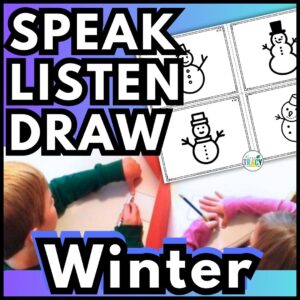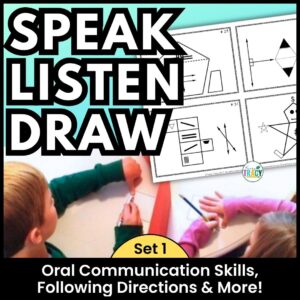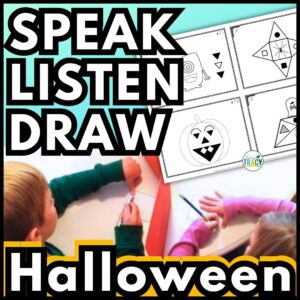This activity is a great to tool to practice oral and written communication skills as well as reinforce math vocabulary, estimation, and measurement skills. Originally, I created this resource as a way to help students be more thorough and clear in their process writing. I was specifically interested in helping them recount their process for building STEM challenge designs and learning to write effective procedures for science labs and experiments. While I always loved the make a peanut butter and jelly sandwich activity, sometimes you don’t want to get into the mess (and allergies)! I’ve got a freebie for you to try at the end!
I created a set of task cards that require students to describe relative size and position of various shapes, lines, and angles [triangle (right, acute, obtuse, scalene, equilateral, isosceles), square, rectangle, parallelogram, hexagon, pentagon, octagon, circle, oval, parallel lines, intersecting lines, perpendicular lines, etc.] Though students don’t strictly need to use this vocabulary to succeed, it certainly helps!
The cards work for a wide range of ages and they’re a lot of fun. I created a few videos to walk you through several ways to use the cards, as well as some examples of my family going through several of the cards below. I’ve listed their ages and you’ll see their final drawings compared to the original at the end of each clip. I’ve included additional ideas and tips in the resources, including the freebie you’ll find linked at the end.
Watch the Overview
(Transcription at the end of post)
Introducing the Activity to Your Class
Timing: Quick & Easy
Measurement / Estimation Expectations
Example 1
Director: 10 years old
Illustrator: 13 years old
Example 2
Director: 13 years old
Illustrators: 10 & 6 years old
Example 3
Director: 6 years old
Illustrators: 13 years old
Example 4
Director: 34 years old
Illustrators: 13 & 6 years old (the latter dropped out; see why & what can be gained!)
Resources & Freebie
⭐️ Try a Halloween Sample for Free HERE!⭐️
Pin Me!
![This activity is a great to tool to practice oral and written communication skills as well as reinforce math vocabulary, estimation, and measurement skills. Students will describe relative size and position of various shapes, lines, and angles [triangle (right, acute, obtuse, scalene, equilateral, isosceles), square, rectangle, parallelogram, hexagon, pentagon, octagon, circle, oval, parallel lines, intersecting lines, perpendicular lines, etc.] This activity is a great to tool to practice oral and written communication skills as well as reinforce math vocabulary, estimation, and measurement skills. Students will describe relative size and position of various shapes, lines, and angles [triangle (right, acute, obtuse, scalene, equilateral, isosceles), square, rectangle, parallelogram, hexagon, pentagon, octagon, circle, oval, parallel lines, intersecting lines, perpendicular lines, etc.]](https://www.feelgoodteaching.com/wp-content/uploads/2017/10/SLD-VERT-427x1024.jpg)
Transcription of Overview Video
Introduction
Hi, I’m Kerry from Feel Good Teaching and today we’re going to do something just a little bit different. If you’re familiar with my STEM challenges, you know that I always offer process flow templates as an extension activity. Now this is where the students are supposed to basically write step by step how to rebuild whatever they’re design is.
We all know that clear and precise communication is so important for all kinds of writing and in science, this comes in particularly handy when students have to write out procedures for a lab or science experiment, so I like my students to get a lot of practice with this type of writing, and boy do they need that practice.
Task Cards: Quick, Easy and Less Sticky Than a PB&J
If you’ve been a teacher for awhile, you’re probably familiar with the step by step how to make a peanut butter and jelly sandwich activity, but I was looking for something that could be done a little bit more quickly, a little bit more consistently, and a whole lot less sticky. With that in mind, I created some task cards to practice this essential skill. You can use them with a variety of age groups.
I call them Speak, Listen, Draw cards and they’re fantastic because they can be used to practice academic vocabulary, things like measuring, estimation, geometry, speaking and listening comprehension, as well as reading and writing. On top of that, they’re actually pretty fun. Last year, I brought them home for Thanksgiving and people in my family from ages four to 34 wanted to get in on the fun and improve their skills and I’ll be showing you a few clips throughout this video of them working on these cards. Why don’t we quickly try one out for fun? Pause the video, go grab yourself a piece of scratch paper and a pencil and we’ll get started.
Instructions: Broken Down Step by Step
In the center of the page, draw a square tilted on it’s side so that one vertex is pointed up and slightly to the right, sort of like a diamond. Coming off of the bottom vertex of the square, draw a small, equilateral triangle, about one quarter the size of the square. Connect it to the vertex pointed to the right, draw a circle about the same size as the square, maybe a tiny bit smaller. Coming off the vertex pointed left, draw another equilateral triangle, but this one is about the same size as the square and circle.
Ready to see how you did? Were my directions perfect? Probably not. Did you find yourself wanting to ask clarifying questions? I would guess yes. I’m going to walk you through a few different ways to use this activity, including ways to up the difficulty if you want to give your students an extra challenge.
You’ll want to partner students up. One student is the director and gets a card that has a drawing on it. The other student is the illustrator and they just get a blank sheet of paper. I usually have the students put up file folder dividers because I don’t want the director or the illustrator to see what the other one has on their paper until the very end. And the director is only allowed to use words, no talking with their hands or motioning in order to give the directions.
Considerations: Questions, Difficulty Level, Changing Roles, Around the World
One thing to consider is whether or not you want to allow the illustrator to ask clarifying questions of the director. Now, at the beginning when students are first using these activities, I always allow clarifying questions. But one way to increase difficulty over time is to start to take that opportunity away, meaning the illustrator is not allowed to speak at all, they must simply do their best job based on the directions that they’re hearing from the director.
Bethany: Divide that rectangle into four pieces-
Michael: Like a line across and a line down the middle?
Bethany: -so that it’s a cross, that it’s like a T.
Another interesting way to do this is in groups where there’s one director, and three illustrators. Now in this case we want dividers so that nobody can see what is going on in anybody else’s cards. What I like about this approach is it makes it sort of clear, for both the director and the illustrator, how they’re doing with their speaking or listening skills. Because if, for example, all three illustrators have the same mistake from the original card, well, that’s probably something that the director needs to clarify.
On the flip side, if one illustrator has something sort of strange on his or her card, but the other two didn’t, well, then maybe that’s an indication that the illustrator either wasn’t listening very carefully, or maybe there was some academic vocabulary used that he or she was not familiar with.
Another variation I really enjoy is something I call Around the World. Now, in this one, every student in the class has a director card and they’ll probably have, let’s say, three or four illustrator cards, because this is going to be done in several rounds. So as student one, I give my directions to student two. They draw. Student two gives their directions to me. I draw. We can give each other feedback, but then right after that we’re going to switch and get a new partner. But we’re going to keep our same cards.
You’ll repeat that, say, three or four rounds, so the director is getting an opportunity three or four times in a row to refine the directions on a single card. At the end, you can have them report on how they hopefully did refine and change the directions over time to make things more clear.
Another way you can do Around the World is to have the students actually trade their director cards before they move to round two. So that would mean whatever I illustrated in round one, I’m now taking as the director card to round two. Now I’m going in with the experience of what it was like to listen to the directions and what might have been unclear to me, so that I can improve upon that for round two.
Using This Activity in Your Classroom
You can probably already see a lot of different ways to use this in your own classroom, but I find that they’re really great for early finishers, include them in your sub-plans and just have them handy for when you’ve got five minutes left in class. You can use this as a homework assignment, where the students are giving directions to a parent or a sibling.
You can put this into reading and writing centers, you can do a tongue-tied version, similar to Taboo, where there’s a list of words the students are not allowed to use.
The Resource: Printable Cards, Examples, Teacher Tips
You can challenge students to give the directions in the fewest number of sentences possible, which is great if you’re working on compound and complex sentences, or you can even go for the fewest total number of words. And you can use pretty much any kind of drawings for these, but if you want to save some precious time, check out the resource. This resource gives your students consistent, quick practice with speaking and listening, estimation and measurement, geometry and even reading and writing, depending on how you use them.
You’ll get an introduction overview with logistics and set up considerations. In Teacher Tips, you’ll find different ways to use the cards, ideas for increased challenge, a sample script for introducing the activity, and discussion points. You’ll get 44 director’s cards, four per page. You’ll also find illustrator’s cards and pages you can use in reading and writing centers. This resource is set number one in the Speak, Listen, Draw series. You may also like the Halloween set and the Halloween freebie to try before you buy. Links can be found in the description below the video.
I hope you and your students have a great time with this. Make sure you like, subscribe, follow, what have you, so you don’t miss anything. I hope you have a great week packed with feel good teaching moments. I’ll see you next time.

![This activity is a great to tool to practice oral and written communication skills as well as reinforce math vocabulary, estimation, and measurement skills. Students will describe relative size and position of various shapes, lines, and angles [triangle (right, acute, obtuse, scalene, equilateral, isosceles), square, rectangle, parallelogram, hexagon, pentagon, octagon, circle, oval, parallel lines, intersecting lines, perpendicular lines, etc.] Though students don't strictly need to use this vocabulary to succeed, it certainly helps!](https://www.feelgoodteaching.com/wp-content/uploads/2017/10/SLD_HORZ-400x400.jpg)
![This activity is a great to tool to practice oral and written communication skills as well as reinforce math vocabulary, estimation, and measurement skills. Students will describe relative size and position of various shapes, lines, and angles [triangle (right, acute, obtuse, scalene, equilateral, isosceles), square, rectangle, parallelogram, hexagon, pentagon, octagon, circle, oval, parallel lines, intersecting lines, perpendicular lines, etc.] Though students don't strictly need to use this vocabulary to succeed, it certainly helps!](https://www.feelgoodteaching.com/wp-content/uploads/2017/10/SLD_HORZ.jpg)




